AI-Powered Automation Recipes for Smarter Operations
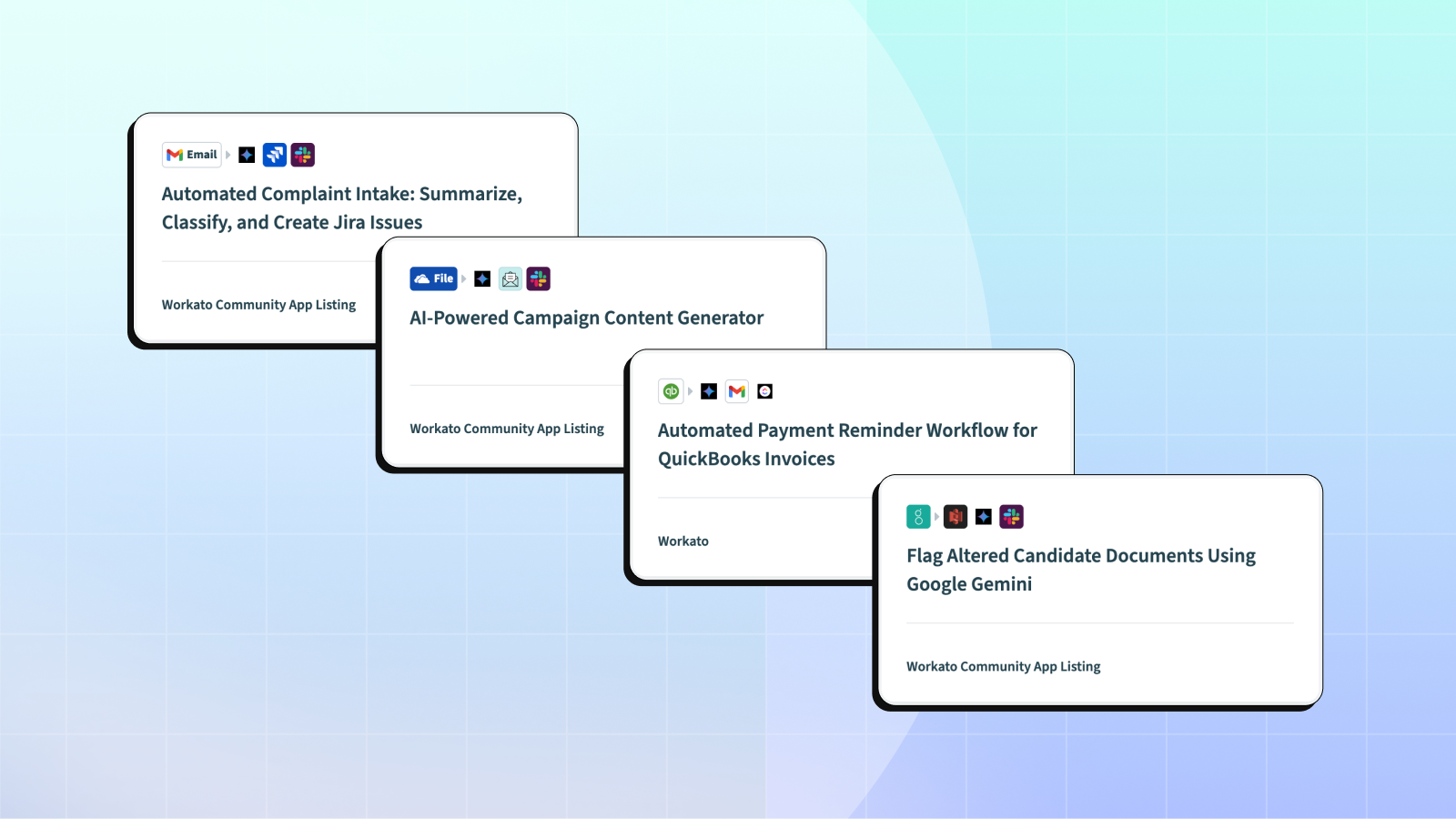
AI-Powered Automations That Eliminate Manual Work Across Your Most Critical Departments
1. Smart Complaint Intake: Summarize, Classify, and Create Jira Issues
This automation streamlines the complaint intake and triaging process by integrating Gmail, Google Gemini, Jira, and Slack. The recipe is triggered whenever a new email is labeled as “Customer complain” in Gmail. It leverages AI capabilities to analyze the content of customer emails, intelligently classify the complaint, and log it as a Jira issue for further tracking and resolution. The process ensures that both email text and attachments are captured and associated with the issue ticket for complete context.
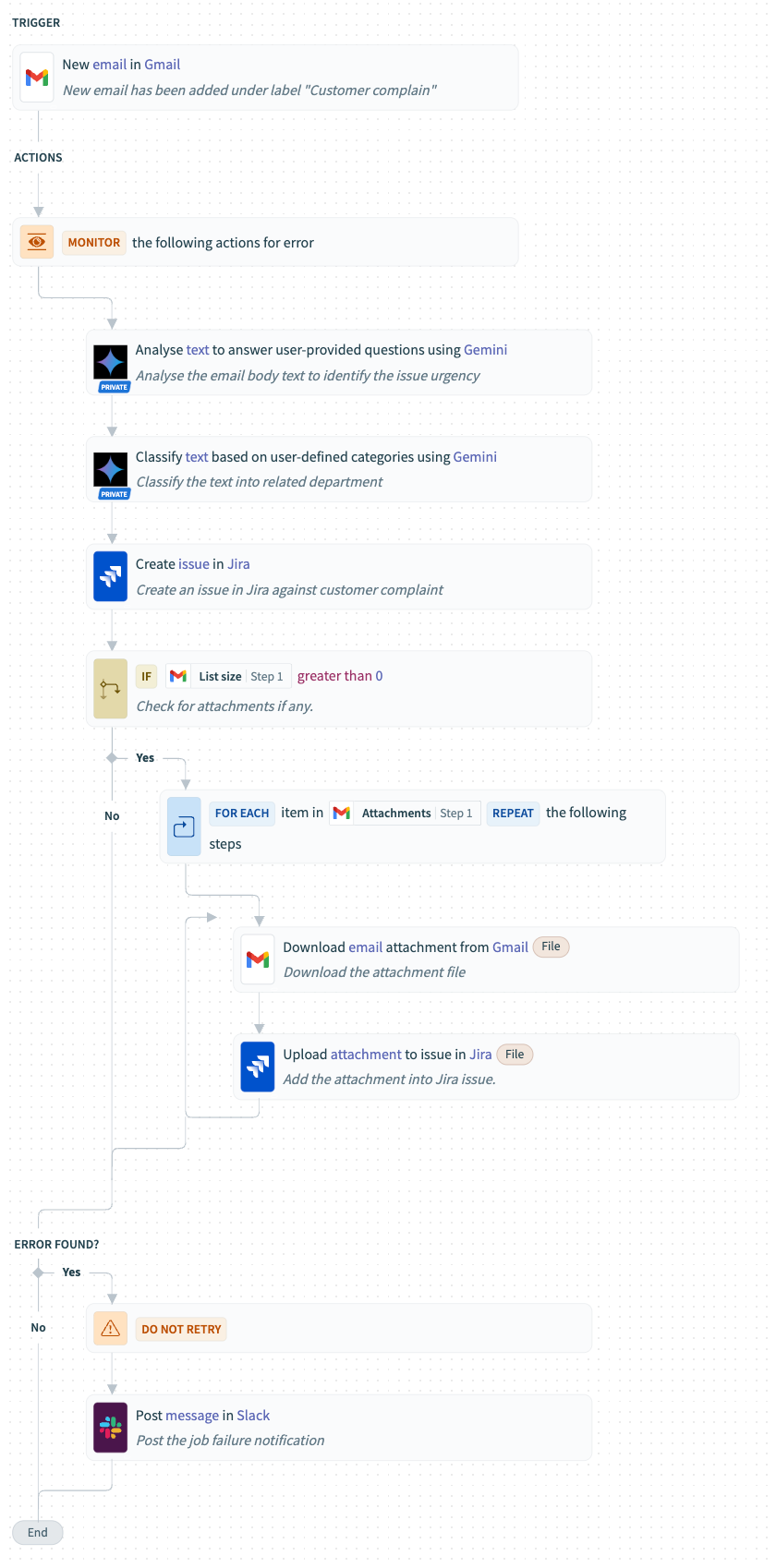
How the automation works:
When a new email arrives under the “Customer complain” label, the email body is first sent to Google Gemini to analyze the text and answer user-defined questions—such as identifying urgency or summarizing key concerns. The analysis output is then passed back to Gemini using its classify action, which categorizes the complaint into the appropriate department (e.g., Billing, Support, Technical). After classification, a Jira issue is created using the collected insights. If the original email includes any attachments, the recipe extracts and uploads them directly to the corresponding Jira ticket. As a safeguard, if the recipe encounters any errors during execution, a failure alert is posted to a designated Slack channel.
Why this automation isimpactful:
This automation reduces manual handling of customer complaints, accelerates triaging, and improves accuracy through AI-based classification. By automatically creating Jira issues with detailed context and supporting files, it ensures that nothing gets missed and teams can respond faster. It also improves operational visibility with failure alerts in Slack, helping support teams stay on top of critical issues without constantly monitoring the integration manually. This results in more efficient ticket management and a better customer experience overall.
Start building in Workato
Feel free to check out the recipe here for a ready-to-use version that you can easily duplicate and implement.
2. AI-Powered Payment Reminder Workflow for Overdue QuickBooks Invoices
This automation recipe is built to streamline the follow-up process for overdue invoice payments in QuickBooks. It ensures timely communication with customers and internal coordination within the finance team, reducing manual effort and minimizing delays in payment collections.
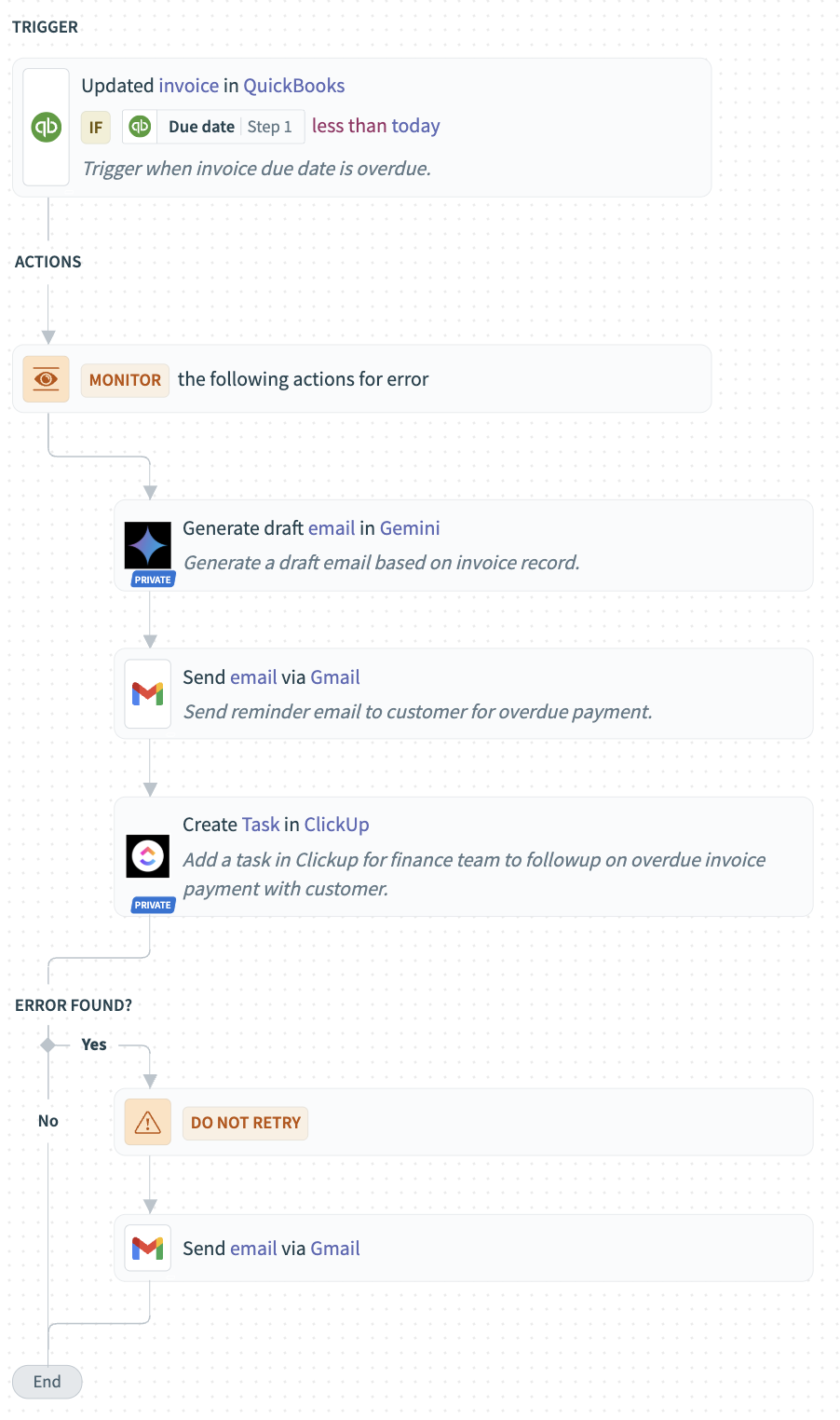
How the automation works:
The recipe is triggered when an invoice in QuickBooks passes its payment due date. Once triggered, it uses Google Gemini to draft a professionally worded payment reminder email tailored to the customer. This email is then automatically sent to the customer using Gmail. In parallel, a follow-up task is created in ClickUp for the finance team so they can track and manage the overdue payment internally. If any step in the recipe encounters an error—whether it’s during drafting, sending, or task creation—an alert email is immediately sent to the support team containing the error message and relevant recipe context for troubleshooting.
Why this automation is impactful:
This automation helps maintain healthy cash flow by ensuring overdue payments are promptly followed up with minimal manual intervention. By integrating intelligent email drafting with task management and alerting, it keeps both external communication and internal accountability in sync. The support team’s immediate notification on failure ensures operational reliability and quick resolution, making the accounts receivable process more efficient and dependable.
Start building in Workato
Feel free to check out the recipe here for a ready-to-use version that you can easily duplicate and implement.
3. Intelligent Campaign Content Generator: Auto-Convert Images to Promotional Emails
This automation is triggered when a new marketing campaign poster is uploaded to a designated OneDrive folder. It automatically analyzes the image and generates a ready-to-use promotional email. The goal is to streamline campaign launch efforts by reducing manual work and speeding up content delivery. The email is then sent to the original requester for posting on social media platforms.
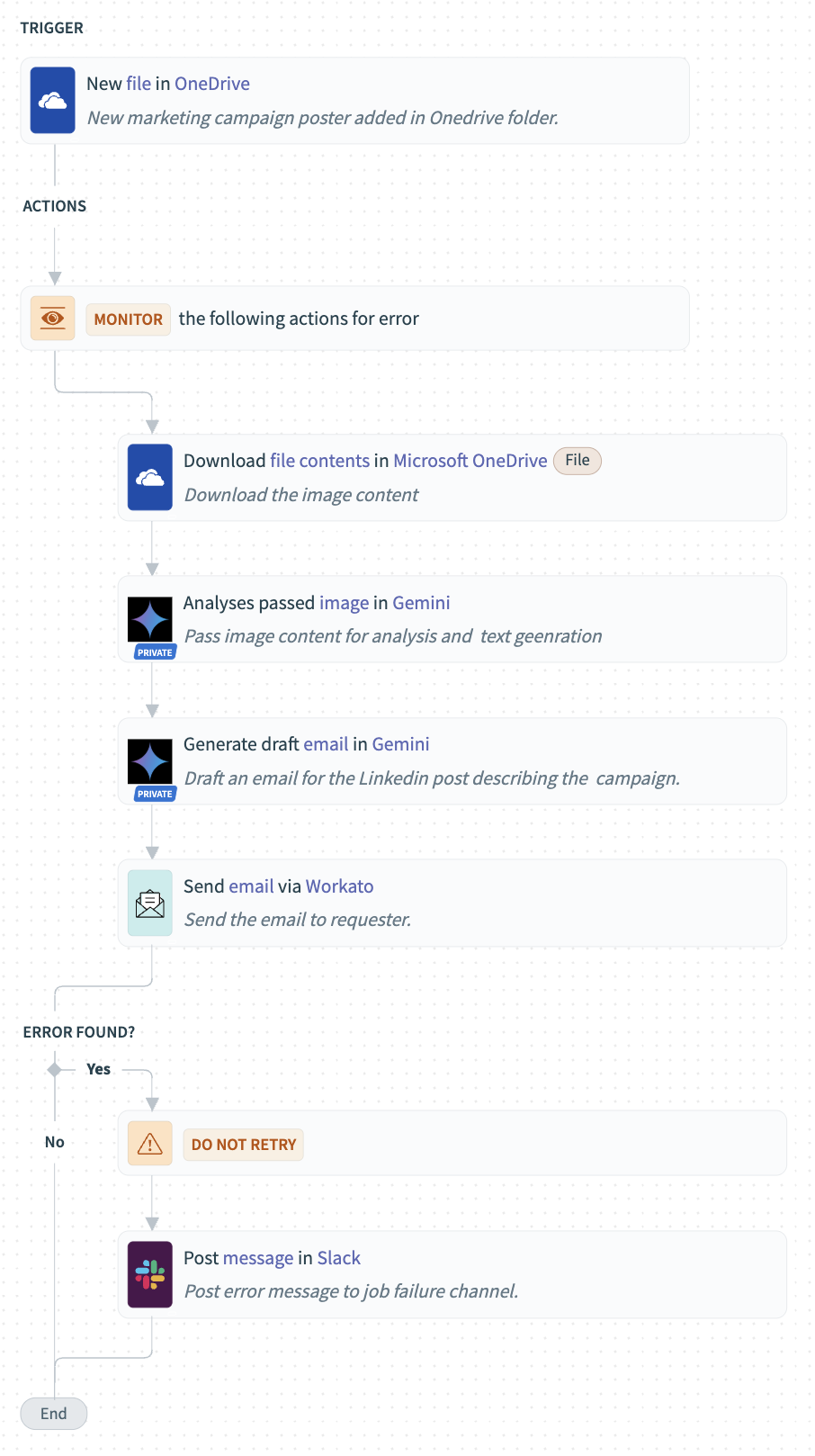
How the automation works:
When a new file is detected in the specified OneDrive folder, the recipe downloads the file content using the OneDrive “Download file” action. The image is then analyzed by Google Gemini to understand its content and context. Based on the analysis, Gemini is instructed to draft an email suitable for promoting the campaign on social media. This email is automatically sent to the requester, making it easy for them to launch the campaign. If any part of the process fails, a notification is posted to the “Job Failure” Slack channel to alert the team.
Why this automation is impactful:
This automation significantly reduces the time and effort involved in preparing social media content for new campaigns. By combining AI image analysis and auto-generated email drafts, it ensures faster turnaround and consistent messaging. It also adds reliability by proactively notifying the team of any process failures, ensuring that nothing falls through the cracks.
Start building in Workato
Feel free to check out the recipe here for a ready-to-use version that you can easily duplicate and implement.
4. Intelligent Document Integrity Scanner: Unmask Falsified Candidate Documents with Google Gemini
This automation is triggered whenever a candidate uploads a document to their Greenhouse profile. It checks each uploaded file to determine if it is an image, and if so, evaluates the image for signs of tampering or low-quality reproduction. The evaluation is powered by Google Gemini’s AI capabilities. If a document appears suspicious, a note is automatically added to the candidate’s profile in Greenhouse.
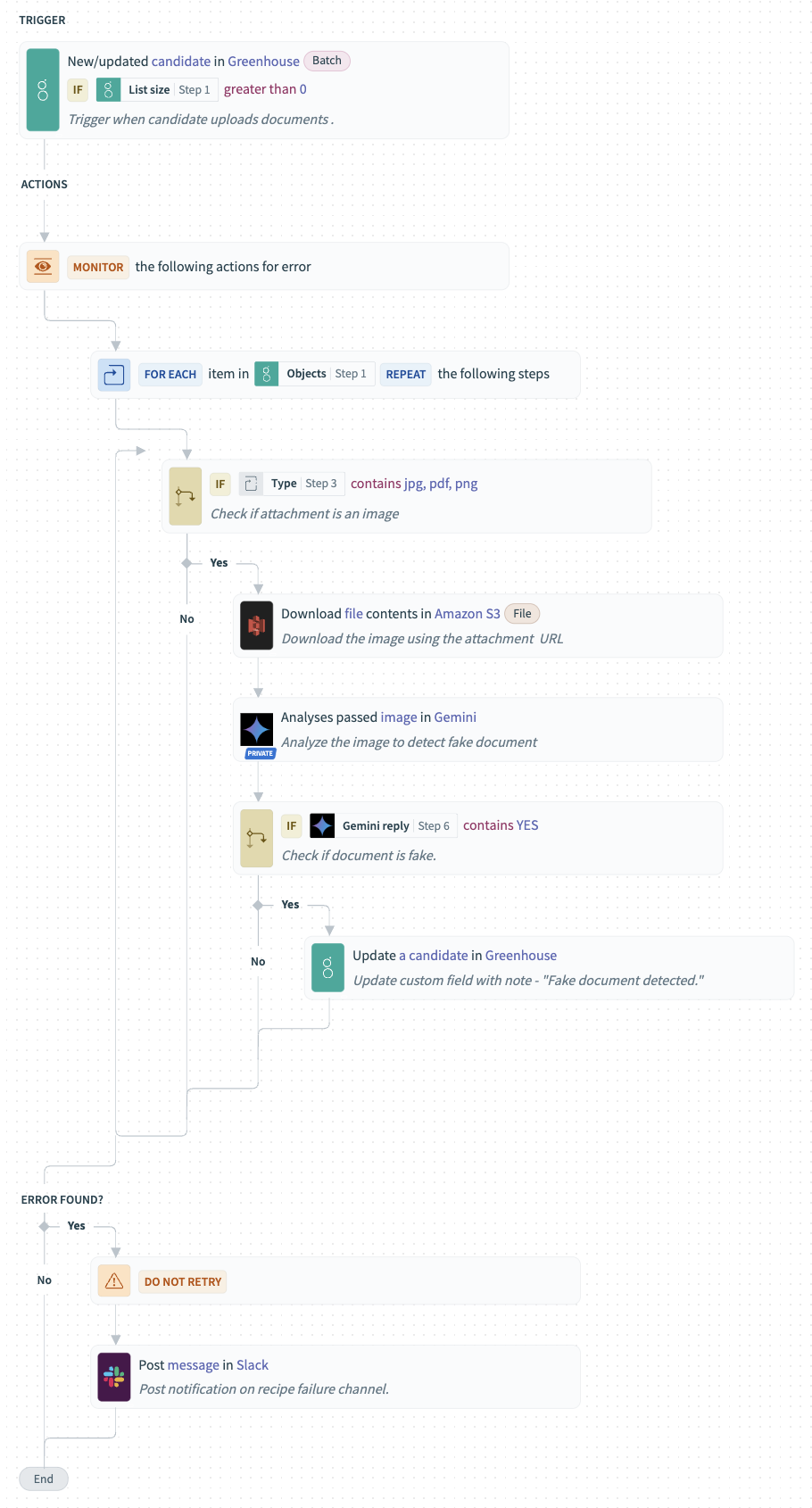
How the automation works:
When triggered by a new document upload, the recipe filters attachments to identify images. For each image, the file content is retrieved from an AWS S3 bucket using the file’s URL. This content is then sent to Google Gemini with an instruction to analyze whether the image appears fake or artificially altered. If the response is “Yes”, the candidate’s custom field in Greenhouse is updated with a note that includes the filename and a warning about document authenticity. Any errors during this process result in a Slack notification being sent to the designated “Job Failure” channel.
Why this automation is impactful:
This automation helps streamline the candidate vetting process by adding an AI-powered layer of document verification. It reduces the risk of fake or tampered documents going unnoticed, saving recruiters time and ensuring greater integrity in the hiring process. The Slack alerts also provide immediate visibility into any failures, so issues can be addressed promptly without manual monitoring.
Start building in Workato
Feel free to check out the recipe here for a ready-to-use version that you can easily duplicate and implement.